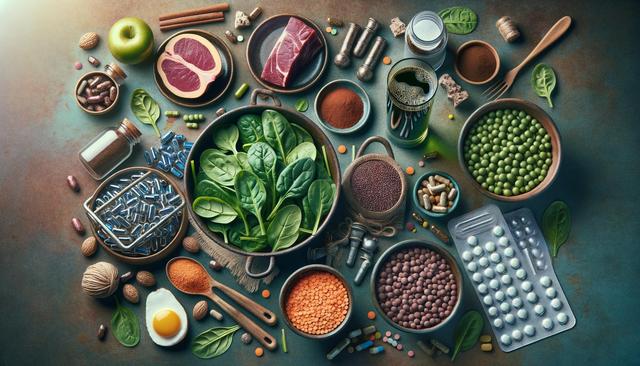Understanding Iron Deficiency and Its Impact
Iron deficiency is one of the most common nutritional concerns worldwide, and it can significantly affect your health and well-being. When your body lacks sufficient iron, it struggles to produce enough hemoglobin—a protein in red blood cells responsible for transporting oxygen. This can lead to symptoms such as fatigue, dizziness, shortness of breath, and pale skin. Recognizing these signs is the first step toward managing the condition. Fortunately, adjusting your diet with the right food for iron deficiency can play a crucial role in restoring balance and energy levels.
Iron deficiency anemia often results from inadequate iron intake, poor absorption, or increased needs during pregnancy or growth spurts. Understanding the root cause helps in selecting the most appropriate iron deficiency diet plan. While supplements are sometimes necessary, dietary changes remain a natural and sustainable way to improve iron levels when guided by proper knowledge and planning.
Types of Iron and How Absorption Works
Not all dietary iron is the same. There are two major types: heme iron and non-heme iron. Heme iron is found in animal-based foods and is more easily absorbed by the body. Non-heme iron, found in plant-based foods, is less readily absorbed but still highly beneficial when paired with the right nutrients. To make the most of your foods highest in iron, it’s important to understand how absorption works and how to enhance it through food combinations.
Vitamin C, for example, significantly boosts the absorption of non-heme iron. Pairing iron-rich vegetables with citrus fruits, bell peppers, or tomatoes can increase their effectiveness. On the other hand, certain substances like calcium, tannins (from tea and coffee), and phytates (from grains and legumes) can inhibit iron absorption if consumed in large amounts alongside iron-rich meals. Simple strategies such as having a glass of orange juice with a spinach salad can make a noticeable difference in iron uptake.
Iron-Rich Foods for Anemia Recovery
Incorporating iron-rich foods for anemia into your daily meals is essential for improving your iron status naturally. Both animal and plant-based sources offer valuable options depending on your dietary preferences. Here are some foods that can help support your recovery:
- Red meat, poultry, and fish (rich in heme iron)
- Spinach, kale, and Swiss chard
- Legumes such as lentils, chickpeas, and black beans
- Tofu and tempeh
- Iron-fortified cereals and whole grains
- Pumpkin seeds, cashews, and almonds
For those wondering what to eat when iron is low, a balanced plate with a mix of these foods can be a practical start. Animal-based sources provide a direct iron boost, while plant-based foods paired with vitamin C-rich fruits or vegetables can significantly elevate iron absorption.
Meal Planning for Better Iron Intake
Creating a consistent and thoughtful iron deficiency diet plan doesn’t have to be complicated. With a few adjustments, you can build meals that naturally support your body’s iron requirements. Begin by structuring your meals around a central iron source and then enhancing it with absorption boosters.
Here’s a sample daily plan for how to improve deficiency iron with diet:
- Breakfast: Iron-fortified cereal with a glass of orange juice
- Lunch: Lentil soup with a side of kale salad and sliced strawberries
- Snack: Roasted chickpeas and a handful of dried apricots
- Dinner: Grilled chicken with quinoa and steamed broccoli with lemon juice
Rotating your protein sources and including a variety of vegetables and grains will not only keep your meals interesting but also ensure you’re covering all necessary nutrients. For vegetarians, emphasizing combinations like beans with tomatoes or tofu with bell peppers can be effective ways to get the most out of plant-based iron sources.
Additional Tips and Long-Term Support
Maintaining healthy iron levels is not just about immediate recovery—it requires ongoing attention to your dietary habits and lifestyle. In addition to choosing the best foods to increase hemoglobin, consider these long-term strategies to stay balanced:
- Limit coffee and tea during meals as they can hinder absorption
- Cook with cast iron cookware to slightly increase iron content in food
- Monitor your iron levels regularly, especially if you’re in a high-risk group such as pregnant women or endurance athletes
- Stay hydrated and maintain overall good nutrition to support digestive health, which plays a role in nutrient absorption
Recognizing the role of diet in managing iron deficiency is empowering. While it’s important to consult a healthcare provider for a complete diagnosis and treatment plan, dietary changes can often provide significant support in managing mild to moderate deficiencies.
Conclusion: Eating Your Way to Better Iron Levels
Addressing iron deficiency through nutrition is a practical and effective approach for many people. By understanding the types of iron, how absorption works, and choosing the right iron-rich foods for anemia, you can build a diet that supports lasting health. Whether you’re looking for foods highest in iron or learning how to improve deficiency iron with diet, small changes in your meals can lead to noticeable improvements in energy and overall wellness. Always pair dietary efforts with medical advice for the best outcomes, and remember—good nutrition is a powerful ally in restoring and maintaining your body’s balance.




Leave a Reply